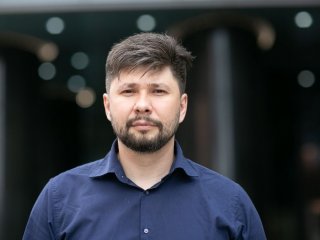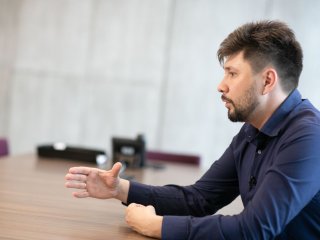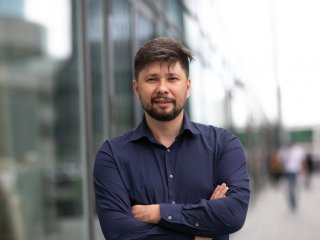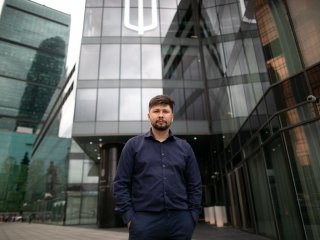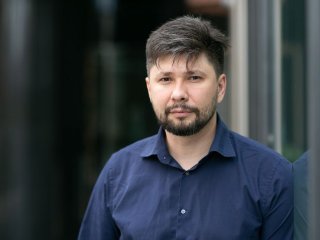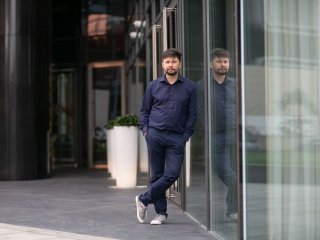The development of new technologies is pushing the boundaries. The things that looked being borrowed from science fiction yesterday, have become a part of our life. Virtual and augmented reality, 3D modeling, and other scientific achievements have already found application in medicine.
This is the topic of our conversation with neurosurgeon of the Medical Center under the Far East Federal University (FEFU), analyst at the Center of National technological Initiative for neurotechnologies, as well as technologies of virtual and augmented reality Artur Biktimirov.
- Specialists of the Far East Federal University (FEFU), Motorica, and Skoltech combined their efforts to create a system of bionic prosthesis sensing. Tell me, please, about this device.
Today, one of the problems of prosthetic care for patients having lost their limbs for some reason lie in the fact that such a prosthesis cannot become a real leg or arm for the patient, as it has no receptors sending information about the location of prosthesis at a certain moment to the brain. That is why the people who have lost their limbs suffer from limited capacity with regard to controlling their prosthesis. That is why the problem that we want to solve is about adding some sensitivity to the prosthesis. For instance, we want to prevent a person from crushing the plastic glass with water, when they take it with the prosthesis, i.e., to stop the pressure imposed on the glass right at the moment when they have taken it. Or to let the signal go to the brain, when the person touches some cold or hot thing with their prosthesis. It will allow for preserving the prosthesis and let the patient understand that the prosthesis is an extension of his arm, and therefore use it in a more active way. Unfortunately, the modern prostheses do not allow it.
The system that we want to design is a sort of electrode. It is to be implanted and attached either to the peripheral nerve or probably to spinal marrow and connected to a microcomputer. This electrode will transmit and receive information from the pressure and temperature sensors on the prosthesis and transfer the data to the brain via a stimulator.
- So, the interaction between the device and human body is based on a sensor that is connected to the prosthesis, isn’t it?
The sensor is connected to the nerve, spinal marrow or brain, which send the signal to the prosthesis.
- Are there any analogs abroad?
Yes, the work has been under way for a long enough time, but no serious success is observed yet. These are some very expensive technologies as a rule. As for Russia, none has dealt with this problem so far.
- VR technologies are used far beyond the area of computer games. How do VR projects find application in healthcare?
They are practiced in rehabilitation sphere as a rule, as it allows the patient to delve into some environment and perform some interesting exercises or tasks. This aspect adds an element of gamification to rehabilitation. While performing the exercise, the patient not just repeats some operation, but gets points for it for instance. Thus, he/he has some goal which improves the quality of rehabilitation substantially. Besides, the virtual and augmented reality is used today in planning, say, surgical operations. It has become possible to upload image to the virtual environment, look through them and plan the surgical access. Such technologies are raw so far, yet are becoming increasingly more accessible for an ordinary physician or clinic every year.
- Are such technologies used for treating psychological disorders?
Not altogether. They are mostly used in physical rehabilitation. For instance, a rehabilitation platform is now being developed by FEFU jointly with Teslasuit. It is an augmented reality suit which is already tangible. Teslasuit has developed it. The suit is equipped with a large number of myostimulators. In fact, it is a suit for myostimulation.
At present, the physicians attach electrodes and stimulate the muscles in a certain are to make the paralyzed arm work, while this suit is already equipped with in-built myostimulators. Putting it on, the patient dives into virtual reality and starts playing by way of accomplishing certain tasks. If the muscle is paralyzed, the rehabilitation therapist can adjust the stimulation program so that electric signals will be fed to the arm in question making the muscle contract and execute the movement that the patient lacks ability for.
Today, this joint development of our university and Tesla is reality already, and we are carrying out the respective clinical trials. The approval of Health Ministry has been obtained, and we perform such studies.
- Wearing such a suit, the patient can move like they have done before falling ill, right?
Not exactly this way. We can only control the rehabilitation process. Apart from a large number of stimulators that the suit is equipped with, we receive feedback in the form of motion capture and understand that, say, the arm’s deviation from the right trajectory amounts to a certain number of degrees. The data is being registered, so we can control the rehabilitation program. It is important that we can digitize the process, i.e., it is possible to be guided by not only the physician’s experience, but the mathematical model of the paralyzed arm’s wrong movement as well.
- So even the mathematical modeling finds application here, doesn’t it?
Yes, sure.
- The scientists of FEFU have recently launched a platform for control over the state of people with Parkinson disease. Tell me, please, about it.
This platform is not yet developed being work in progress so far.
Today, in pandemic period, the possibility of visiting the clinic is limited enough for the patients. Many diseases are chronic and require permanent medical supervision, but the pandemic prevent the patients from visiting the clinic for consultation, so many of them communicate with the physician remotely, via social networks or messengers. Therefore, we decided to design a platform allowing the physician and patient or their relative to communicate online. The patient will use this platform to perform some tests or record the video of their state of health in accordance with certain scales. We have digitized the existing scales, and the patients regularly fill-in the forms. Thus, the physician will see the diagram of changes in the patient’ state of health on their PC screen. In the longer term, if the patient feels wore they can ask a question to the physician who will introduce correction to the treatment regimen.
However, this system is at the stage of development so far. We have a platform uploaded to the cloud service of MTS which is legally protected as personal data is to be stored there. Now, we are conducting the tests inside the cloud and will transfer the right for access to the first group of patients who are to start testing it. Our present task lies in collecting as much data as possible to understand how to process this data.
Yes, people are talking a lot today about neural networks and artificial intelligence, but the process of structural data collection in medicine has not been fine-tuned yet. Before analyzing the process, we have to understand how to collect and analyze the data in the right way, in order to have the respective statistics and recommend paying attention to certain changes in the patient’s state of health to the doctor. Now, we are proceeding to the stage of data set collection. Thanks to grant Far East Start (there was a competition last year, and it continue this year as well), we have won funding and created the first MVP application.
- The platform will work as a mobile application, won’t it?
Yes, as a mobile application, yet the access to it is closed so far.
- Do the students of FEFU take part in these activities?
Sure, the students take part in this research. Besides, we had an interesting communication. During workshop Island 10-21 held 2-3 years ago, we worked with a group of school children and suggested digitizing Parkinson disease to them. They took interest in this project and continued working on it when the workshop was over. Now, they study in Saint Petersburg, and the team of platform developers includes the boys and girl who have got enthusiastic about the idea during Island 10-21 in Vladivostok.
By the way, there are many skeptics doubting the efficiency and use of such major events today. Naturally, they are efficient and helpful, but it does not mean that all 100% of the participants will start doing something tomorrow. Even if 20% of them feel enthusiastic about the idea and start implementing it, it will be an excellent efficiency coefficient. The mission of these major events lies in finding such young people, get them interested and plunge into the process.
- What country is the world leader today in the field of high-tech medical developments?
The USA is, as they invest a lot in this area, the one of neural technologies at least. One of the most vivid examples is Elon Musk’s Neuralink – one of the most expensive projects globally. Unfortunately, the rest of the world is falling behind. Okay, we will try to catch up with them.
- Is cooperation with foreign scientist aimed at development of this area possible?
It is not only possible, but necessary as well. Science should be beyond politics. Attending international forums, we communicate to foreign colleague and share the results of research.
- Neuro-engineering uses the engineering methods of treating nervous system. What methods are in question? Which of them have proved their efficiency?
As for the development of medicine, it is hardly possible without engineering technologies. For instance, I deal with functional neurosurgery, implanting neurostimulators – the very chips that people are afraid of for some reason. These are high-tech devices. An electrode made of special materials fit for humans is implanted into the patient’s head. The system is actually connected to a microcomputer which is sewn into collarbone or lumbar region. And controlled with the help of a programmer unit.
These are engineering technologies, and the development of neurosurgery is almost impossible without them. We cannot imagine our life without them today. For instance, while excising a tumor, I cannot imagine how it can be done without microscope and navigation. Surgery of high-quality is impossible without technologies.
Getting ready for a surgical operation today, we do not just think through where to make an incision, etc., but upload the images into the navigation station and study the safest possible way to approach the tumor that allow us to avoid affecting the functionally-significant regions responsible for movements of arms, legs, as well as speech, etc. Moreover, the patient is awake during the operation. They do not sleep, but are talking to us. These are technologies that raise the quality of our work. We just cannot do without them today.
- You have mentioned implanting technological devices, chips. Can you highlight this issue in detail?
They talk a lot about chips today intimidating the public. As a rule, it is done by people who have nothing to do with healthcare and neuro-technologies. They try to attract audience. It is wrong to convey information you know nothing about to people. Before dealing with neurosurgery, I have graduated from the medical institute (6 years), worked as an interne (1 year), attending physician (2 years), etc. Moreover, the process of education is continuous: I visit forums and read special literature. So, I boil over seeing a young blogger to tell me that chips are universal evil.
In general, chips are devices that have existed for a long enough time. The first implantation of neurostimulators was carried out back in 1980s, while the first brain stimulation was performed by professor Benabid in France for treating Parkinson disease. After that the countdown began. At present, over 150,000 patients all over the world have such stimulators implanted. They do not want to refuse from them, as they cannot do without these devices. Having such a stimulator implanted means better quality of life for them. We can really help to change the patient’s life substantially. When someone starts talking about the conspiracy aimed at microchipping all people to control them, it is bullshit. People are microchipping themselves on their own, when they buy the first smartphone, open their first social media account and upload their personal information there. However, they are in comfort with it, but when vaccination or neurostimulator implantation is offered to them, they immediately begin looking for a trap. These are people who do not need such methods of treatment as a rule, while the patients are looking forward to such an operation.
The physicians of Medical Center at Far East Federal University (FEFU) implemented a new method of implanting a cutting-edge neurostimulator for treating Parkinson disease. The operation, first one in the Far East, was performed at FEFU clinic on October 10, 2018.
It lasts for about six hours. During the installation of electrodes, the patient is fully awake and answers the surgeons’ questions. When the time for implantation comes, the patient sinks into sleep. The installation of device is carried out once in a lifetime, yet the patient has to replace the battery once in five years. The neurologist monitors the work of the device and state of the patient’s health.
- How do such neurostimulators work?
The most common case for brain stimulation is Parkinson disease. We implant electrodes with the help of high-precision equipment which allows for hitting the target 305 mm in size in human brain. It is like striking the aim, when the target is a sparrow on the roof of neighboring building. We hit the target very accurately and withdraw the damaged structure from the process of motor action. If Parkinson disease results in sluggish movements of tremor, we switch on the stimulator, the nucleus working in the wrong way stops ending wrong signal to the brain, and the patient get rids of certain symptoms. Unfortunately, it is impossible to cure the disease so far, but we can make exert an effect on symptoms substantially improving the patient’s quality of life. Very often after having gone through the operation, the patients would send videos to me. Once, one of them has sent a touching video to me. He has a large enough head, so it was hard to put the stereotaxic frame on him. Yet he said that would tolerate any discomfort for the sake of the result, and this structure put strong pressure on the bridge of his nose during 5-6 hours. The final result was fantastic indeed! Being almost unable to move before the operation, he later sent me a video showing how quickly he was moving from one tree to another at some attraction site in Thailand. No one will guess that this man suffers from a serious disease. Just try to explain to him that microchipping is universal evil! Well, microchipping is again a conventional term here.
- Are such technologies a result of work that several scientists have performed?
They are the result of technological evolution, accumulated knowledge and tremendous financial investments.
- Is the task of technologies rendering aid to people among other things?
We should develop instead of standing still. If a patient requires neurostimulators to improve the quality of their life and make them more active, why not to implant them? Why shouldn’t we implant a chip into their brain? Or implant a chip to a blind man so they can see? Or install a cochlear implant to a newly born baby suffering from ear problems so he could hear his mother’s voice? We talk about raising the patient’s quality of life to a new, better level.


